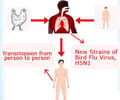New study suggests that the influenza virus may hijack autophagosomes, perhaps using the compartments for viral protein translation.

‘Inspired by the annual 3 to 5 million cases of severe influenza worldwide, the Guinness World Record organization is advertising for individuals or organizations to attempt a record for the most people getting a flu awareness lesson at once.’





The study quantified virus-induced changes in protein levels and found that a majority of the changes are cell-line specific. More specifically, they quantified the protein levels of 70 percent of the roughly 7,000 proteins they could detect using a mass spectrometry-based isotope labeling approach known as SILAC. Influenza infection of lung cells changed the overall abundance of only a few proteins, mostly related to immunity, but SILAC comparisons showed that the virus changes the cellular location of many proteins.
Source-Eurekalert















